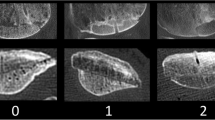Abstract
Objective. To investigate the magnetic resonance imaging (MRI) features of allografts at various time intervals after surgery in patients with osteoarticular allografts.
Design and patients. Sixteen patients who were treated with osteoarticular allografts and who were followed over time with MRI studies as part of their long-term follow-up were retrospectively selected for this study. T1-weighted images were obtained both before and after gadolinium administration along with T2-weighted images. All images were reviewed by an experienced musculoseletal radiologist, with two other experienced radiologists used for consultation. Imaging studies were organized into three groups for ease of discussion: early postoperative period (2 days to 2 months), intermediate postoperative period (3 months to 2 years), and late postoperative period (greater than 2 years).
Results. In the early postoperative period, no gadolinium enhancement of the allograft was visible in any of the MR images. A linear, thin layer of periosteal and endosteal tissue enhancement along the margin of the allograft was visible in images obtained at 3–4 months. This enhancement apeared gradually to increase in images from later periods, and appears to have stabilized in the images obtained approximately 2–3 years after allograft placement. The endosteal enhancement diminished after several years, with examinations conducted between 6 and 8 years following surgery showing minimal endosteal enhancement. However, focal enhancement was noted adjacent to areas of pressure erosion or degenerative cysts. All the cases showed inhomogeneity in the marrow signal (scattered low signal foci on T1 with corresponding bright signal on T2), and a diffuse, inhomogeneous marrow enhancement later on.
Conclusion. We have characterized the basic MRI features of osteoarticular allografts in 16 patients who underwent imaging studies at various time points as part of routine follow-up. We believe that the endosteal and periosteal enhancement observed on MRI during the first few months to 2 years following surgery represents vascular ingrowth and early skeletal repair. The zone of periosteal enhancement could also include the new bone laid on the surface of the allograft through which the soft tissues bind to the cortex. The exact reason for the inhomogeneity in the marrow signal, and the diffuse, inhomogeneous marrow enhancement is not clear. This may represent saponified and/or necrotic marrow fat interspersed with the fibrovascular tissue. The features noted here should provide radiologists with useful information regarding imaging characteristics they can expect to see in other allograft replacement patients.
Similar content being viewed by others
Author information
Authors and Affiliations
Additional information
Received: 14 August 1998 Revision requested: 23 October 1998 Revision received: 2 February 1999 Accepted: 22 February 1999
Rights and permissions
About this article
Cite this article
Kattapuram, S., Rosol, M., Rosenthal, D. et al. Magnetic resonance imaging features of allografts. Skeletal Radiol 28, 383–389 (1999). https://doi.org/10.1007/s002560050534
Issue Date:
DOI: https://doi.org/10.1007/s002560050534




